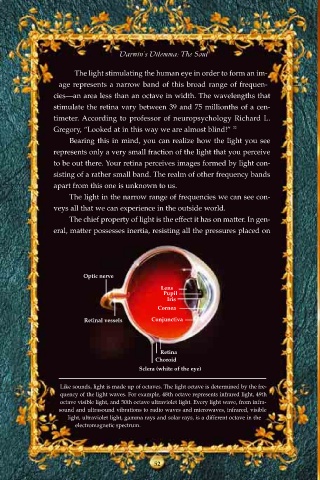Page 54 - Darwin's Dilemma: The Soul
P. 54
Darwin’s Dilemma: The Soul
The light stimulating the human eye in order to form an im-
age represents a narrow band of this broad range of frequen-
cies—an area less than an octave in width. The wavelengths that
stimulate the retina vary between 39 and 75 millionths of a cen-
timeter. According to professor of neuropsychology Richard L.
Gregory, “Looked at in this way we are almost blind!” 32
Bearing this in mind, you can realize how the light you see
represents only a very small fraction of the light that you perceive
to be out there. Your retina perceives images formed by light con-
sisting of a rather small band. The realm of other frequency bands
apart from this one is unknown to us.
The light in the narrow range of frequencies we can see con-
veys all that we can experience in the outside world.
The chief property of light is the effect it has on matter. In gen-
eral, matter possesses inertia, resisting all the pressures placed on
Optic nerve
Lens
Pupil
Iris
Cornea
Retinal vessels Conjunctiva
Retina
Choroid
Sclera (white of the eye)
Like sounds, light is made up of octaves. The light octave is determined by the fre-
quency of the light waves. For example, 48th octave represents infrared light, 49th
octave visible light, and 50th octave ultraviolet light. Every light wave, from infra-
sound and ultrasound vibrations to radio waves and microwaves, infrared, visible
light, ultraviolet light, gamma rays and solar rays, is a different octave in the
electromagnetic spectrum.
52

